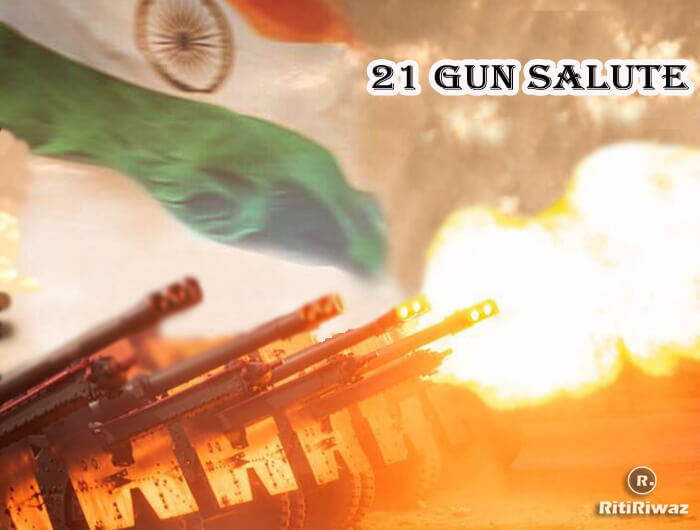21 Gun Salute : All you need to know

The 21 Gun Salute is the highest honor a nation could render. Gun salute is given on many other occasions including Republic Day, Independence Day. At the same time, military honors of the Indian Army are given to those soldiers who have made their special contribution in peace or wartime. Gun salute is also given in state honor. A 21-gun salute is also given during the last rites of the President of India, military, and senior leaders.
26th of January is decreed a national holiday and was recognized as the Republic Day of India. Republic Day is celebrated with festivities and patriotic fervor all around the country. The celebration takes place with a grand parade held at New Delhi from Raisina Hill near the Rashtrapati Bhavan (President’s House), along the Rajpath, past India Gate, and on to the historic Red Fort.
The Prime minister of India lay a wreath at Amar Jawan Jyoti to commemorate the soldiers who sacrifices their lives for our country. The President of India unfurls the Nation Flag and the National Anthem is played along with the 21 gun salute. 21 cannons are fired at a gap of about 2.25 seconds to encompass the entire 52 seconds of the national anthem in three successive rounds of 7 cannons each.
After this follows Magnificient parades by the Indian Army, Navy, Air Force, police, and paramilitary forces. Different states put up their tableaus showing the culture, uniqueness, and diversity of their states,
Why the 21 Gun Salute
A 21-gun salute is the most commonly recognized of the customary gun salutes that are performed by the firing of cannons or artillery as a military honor. The tradition of rendering a salute by cannon originated in the 14th century as firearms and cannons came into use. It is one of the most ceremonial honors paid to officers that are killed in the line of duty. Originally warships fired seven-gun salutes; seven planets had been identified and the phases of the moon changed every seven days.
A British vessel at the time was mounted with seven weapons in accordance with the biblical significance of the number seven. So, in order to show peaceful intent, seven shells were fired in the sea from the warship. But shore weapons, which had abundant gunpowder, fired 3 shots for every shell fired by the warship and hence the 21-Gun tribute came into existence as a salutatory tradition. In time, 21 guns became the highest national honor.
By agreement, the international salute was established at 21 guns, although the United States did not agree on this procedure until August 1875.
Who gets 21 Gun Salute in India?
India has inherited the tradition of a 21 gun salute from the British Empire. Before independence, the highest salute was the 101 gun salute also known as the royal salute which was given only to the Emperor of India (British Crown). This was followed by a 31-gun salute or royal salute. It was presented to the Queen and members of the royal family. It was also presented to the Viceroy and Governor-General of India.
After Independence, the head of state of the Republic of India as President is honored with a 21-gun salute on several occasions. Both the Indian National Flag and the President are honored with a 21-gun salute during Independence Day and Republic Day.
The entire sequence of the Command being given by the Commandant of the PBG, the unfurling of the flag, and the guns going off is a closely synchronized action. The battery should give the 21 gun salute in complete synchronization with the national anthem from the first gunfire to the last. And this it does without fail on each occasion.
Also during the last rites of the President of India, the senior leader gets a 21-gun salute. The 17 gun salute is given to Chief of Naval, Army, and Air Force staff, and 19 gun salute is given to a foreign head of a state who visits India or any senior leader of India visit another country.






